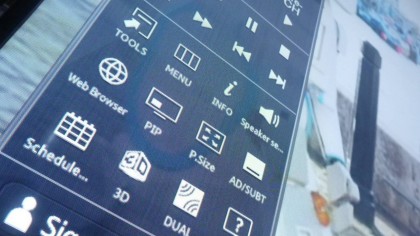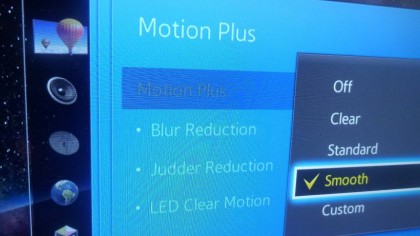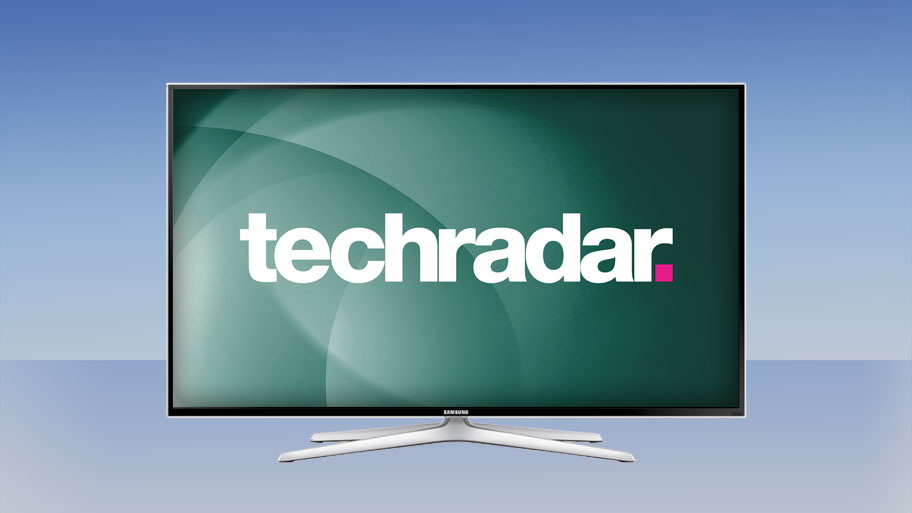Why you can trust TechRadar
After a slick set-up procedure covering smart TV terms and conditions and digital tuning, the UE48H6400 tells us that 'the more you use it, the smarter it will get'. Not with the picture presets, it doesn't.
As usual on Samsung TVs, they're ill-judged. The scorch-yer-eyes-out Dynamic mode is worth glossing-over in both senses. Regarding the Natural and Movie modes; in the former the 'blue marble' of Earth's oceans in Gravity look bright sky blue, while on the latter they're a muted turquoise.

The movie mode is by far the comfiest to watch, though, largely because on all other presets the colours and whites are so bright that the glass is visible as a stationary sheen. Use the Movie mode as a basis, tweak the colour downwards a touch and lower the backlight still further and you should be set.
Stick on a Blu-ray and the UE48H6400 is all about detail and contrast. The slowly turning Earth in Gravity is awesome in its texture, and it's flanked by a deep space studded with super-fine pricks of starlight. As the shot moves, those stars do begin to blink and lose their one-ness – and in one shot space looks more like a moving shoal of fish than fixed points of light (perhaps Samsung is making room for 4K?) – but overall we're hugely impressed by the Full HD detail.

As well as being rich in detail, the UE48H6400's images are very clean, with virtually no picture noise even in complex mixed brightness scenes. In one shot there's an illuminated Earth on one side, brightly-lit astronauts in the centre, and a complete blackout hosting the Milky Way on the other.
Contrast is decent enough, but the real highlight of the UE48H6400 is its stunning black levels. Thanks to some devilishly effective Micro Dimming, the black backdrops to the space shuttle are inky and involving, with some luscious depth added – and we spotted the Milky Way behind the dark silhouette of a still-spinning astronaut. Planet Earth in the background doesn't look half bad, either, with those black levels boosting colours to extraordinarily convincing, yet subtle saturations.
Even when watched in a total blackout – and especially when the UE48H6400 is showing a near-total black image – we didn't notice much in the way of LED light leakage, nor clouding or blotching. There are clusters of LEDs behind the UE48H6400's panel, but they're thankfully invisible unless you watch from the wings; the viewing angle isn't particularly restrictive, but the image is far better watched head-on.
Sign up for breaking news, reviews, opinion, top tech deals, and more.

However, the UE48H6400 does suffer from some motion blur. It's not highly noticeable, but this is no plasma. With debris rushing across the screen and Stone spinning around in low-Earth orbit, Samsung's Motion Plus circuitry does it best. However, despite Motion Plus being endlessly tweak-able, we couldn't find a happy medium. As usual, the Clear or Standard settings are OK, but it's not the cleanest processing around.
Gravity in 3D looks excellent on the UE48H6400, with little in the way of crosstalk in what is an unusually fluid performance, albeit with some flicker (if you look for it). Donning the specs takes a little of the ultra-bright glare of peak whites away while adding to the deepness of blacks, too.
The UE48H6400 does the basics well, too, with excellent Freeview HD images and cleanly upscaled standard definition channels.
Current page: Picture quality
Prev Page Introduction and features Next Page Usability, sound and value
Jamie is a freelance tech, travel and space journalist based in the UK. He’s been writing regularly for Techradar since it was launched in 2008 and also writes regularly for Forbes, The Telegraph, the South China Morning Post, Sky & Telescope and the Sky At Night magazine as well as other Future titles T3, Digital Camera World, All About Space and Space.com. He also edits two of his own websites, TravGear.com and WhenIsTheNextEclipse.com that reflect his obsession with travel gear and solar eclipse travel. He is the author of A Stargazing Program For Beginners (Springer, 2015),
